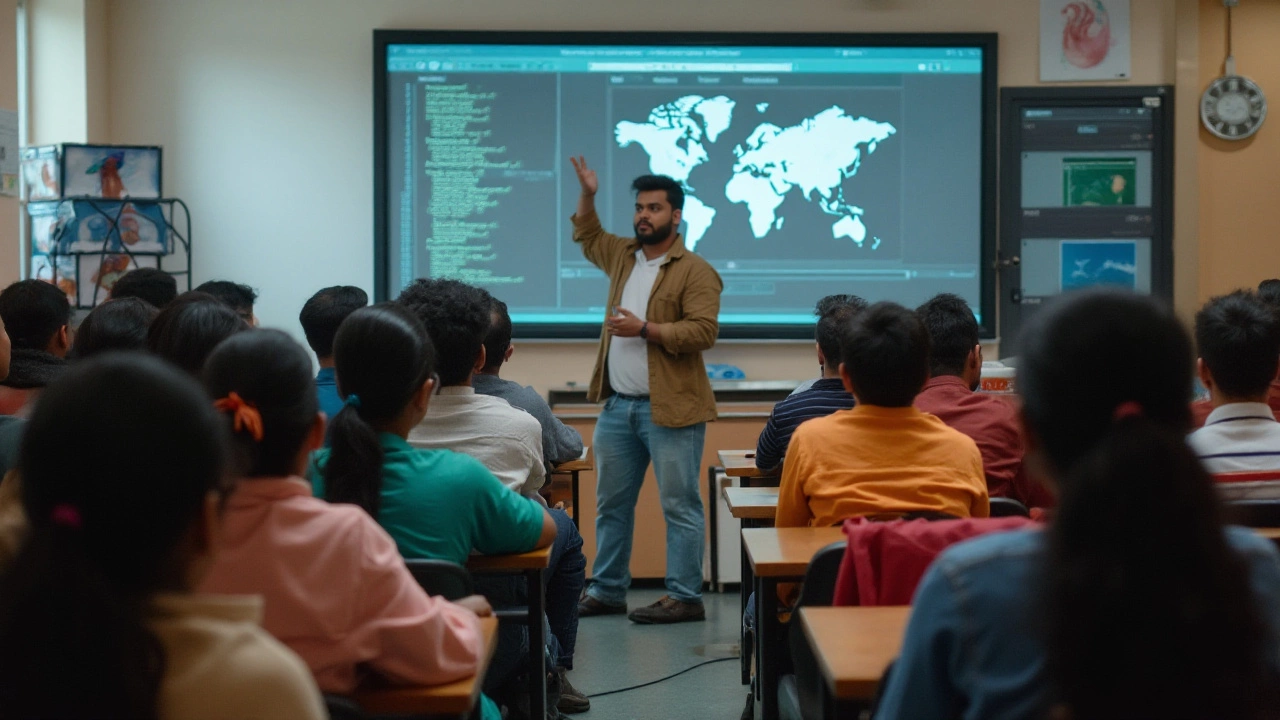Python stands out as one of the most beloved programming languages in the tech world. Its appeal lies not just in its readability and straightforward syntax but also in its impressive range of applications. From empowering burgeoning startups to aiding scientific research, Python's reach is vast and ever-expanding.
For those stepping into the world of coding, Python offers a gentle learning curve, making it an ideal choice for beginners and professionals alike. This article will explore the multitude of ways Python is utilized, uncovering its potential in web development, data science, automation, game design, and more. Dive in to see how Python can open up new horizons in your career and transform ideas into reality.
- Introduction to Python's Versatility
- Python in Web Development
- Data Science and Python
- The Role of Python in Automation
- Game Development with Python
- Learning Python: Tips and Resources
Introduction to Python's Versatility
Python’s initial creation in the late 1980s by Guido van Rossum was inspired by a desire to bridge the gap between the way we think and the way computers understand code. The vision was to craft a language that would be both powerful in function and simple to grasp. Fast forward to today, and it is clear that this vision has borne fruit; Python is a cornerstone in modern programming. Its syntax mimics plain English to an extent that even a non-coder can often guess what a piece of code is meant to perform. This simplicity establishes Python’s versatility since developers can focus more on solving problems than decrypting the syntax itself.
Python’s flexibility extends beyond readability. As an open-source language, its community support is unparalleled. With an ever-growing library of frameworks and tools, Python caters to diverse needs across various domains. Be it web development frameworks like Django and Flask, or scientific libraries such as NumPy and SciPy, Python ensures developers have an arsenal at their disposal to tackle almost any task. In recent years, its prominence in booming fields like data science and artificial intelligence has surged, driving a new wave of programmers eager to harness its power. Astoundingly, Python has consistently ranked among the top languages in the TIOBE Index, a testament to its wide-reaching influence.
"Python has been an integral part of Google since the beginning and remains so as the system grows and evolves. Today dozens of Google engineers use Python, and we are looking for more people with skills in this language." - Peter Norvig, Director of Research at GooglePython is highly adaptable and tailored in a way that aligns with various programming paradigms. This adaptability makes it a favorite among both novices taking their first steps and experts designing complex systems. Whether utilizing Python for object-oriented programming, procedural techniques, or even functional programming, its dynamic nature accommodates a workload that's as diverse as it is demanding. What truly sets Python apart is its capability to integrate smoothly with languages like C or Java, meaning it plays nicely with other technologies rather than standing alone, isolated.
Another aspect of Python’s versatility is its role in educational settings. More and more educational institutions are incorporating Python into their computer science curricula, recognizing its capacity to teach fundamental programming concepts without overwhelming students. Its wide reach can be seen in its application in anything from introductory university courses to empowering school children with the basics of coding. Integrating Python in education cultivates an early appreciation for problem-solving skills and logical thought processes required in the tech industry. By fostering these skills early, Python doesn’t merely train programmers but rather inspires the innovators of tomorrow.
Python in Web Development
For many, web development represents the heart of the digital experience, and Python has firmly established itself as a core player in this domain. Its simplicity and powerful capabilities make it a go-to language for developers seeking to build dynamic web applications. Python's flexibility allows for the seamless integration of various frameworks to streamline web development projects. Notably, Python programming utilizes frameworks like Django and Flask, which are acclaimed for their robustness and ease of use. Django, often described as the web framework for perfectionists with deadlines, provides a high-level structure that promotes rapid development. It's known for its 'batteries-included' philosophy, offering a comprehensive toolkit that handles the typical web needs—from content administration to security features, all without sacrificing scalability or performance.
Flask, on the other hand, is a micro-framework that emphasizes simplicity and minimalism, making it a popular choice for smaller projects or those requiring more tailored solutions. Both frameworks benefit from extensive libraries and a vibrant community, ensuring developers can easily find resources, support, and collaboration opportunities. A remarkable appeal of these technology tools lies in their ability to use Python’s inherent clarity to maintain clean and manageable codebases even as applications grow in complexity.
Python’s influence extends beyond just frameworks; it enhances server-side functionalities, making it indispensable for creating interactive pages. This is achieved through seamless integration with front-end technologies like HTML, CSS, and JavaScript. Many modern web applications take advantage of this synergy, where Python handles the back-end processing that communicates with responsive front-ends, enriching user experiences across the board. Some argue that Python's role in web development is akin to having a Swiss Army knife for digital challenges. As Chris Wanstrath, co-founder of GitHub, once said,
"By using Python, we accomplished more with less effort", showcasing the efficiency and agility Python brings to web development.
Whether developing an e-commerce platform, a content management system, or a social networking site, Python's scalability and security features give it an edge, fulfilling various business requirements. In the realm of web development, where rapid advancement and user-centric designs reign supreme, Python emerges as a perfect ally.

Data Science and Python
Data science has surged as a crucial field, driven by the demand for data-driven decision making in businesses and organizations globally. Python, with its robust framework and libraries like NumPy, pandas, and Matplotlib, has become a cornerstone for many data scientists. Its simplicity allows analysts to focus on interpreting data rather than deciphering complex programming syntax. This makes Python particularly suited for this domain, as the clarity of the language enables sharing and reviewing code within teams efficiently.
At the core of Python's appeal for data science is its extensive range of libraries tailored for varied data tasks. Pandas, for instance, provides high-level data structures and data analysis tools, while NumPy supports large, multi-dimensional arrays and matrices, going beyond typical capabilities. These tools streamline the manipulation of data, making processes faster and less prone to errors. Additionally, visualization libraries such as Matplotlib and Seaborn empower data scientists to create appealing visual representations of datasets, which is crucial for sharing insights and findings with stakeholders.
Its integration with other technologies also boosts Python's popularity in data science. The language works effortlessly with tools for machine learning like TensorFlow and sci-kit-learn. This allows data workers to develop algorithms that can learn from and make predictions on data swiftly. According to a survey, nearly 70% of data specialists reportedly use Python, showcasing its dominance.
According to Forbes, "Python has rapidly risen the ranks in data science, hailed for its clarity and ease of use compared to other programming languages."
Python's Role in Machine Learning
Python stands tall in machine learning as well. Algorithms, which constitute the backbone of machine learning, require repetitive processing, which Python handles with ease, providing an easily accessible environment for writing extensive algorithms. Libraries such as sci-kit-learn, designed for Python, play a significant role in this. They're equipped with various tools for model fitting, data preprocessing, model selection, and evaluation, which makes them essential for building machine learning models. Technology professionals seeking to harness the power of data analytics often prioritize mastering Python because of these capabilities.
To start exploring the numeric elegance of this synthesis, set up a Python environment and install Jupyter Notebooks. This open-source web application allows for the creation and sharing of documents containing live code and analytical results, making it an ideal tool for learning and implementing data science techniques. This integration is especially vital for presenting data stories, as it allows for both static and interactive outputs.
Even tech giants like Google and Facebook have integrated Python in their data operations due to its adaptability and power. Such developments highlight how Python is not just a choice for solo developers but a strategic resource for huge operations as well. For those willing to delve deep into data science, mastering Python is an invaluable step, promising efficiency and an expansive community support network.
The Role of Python in Automation
Automation has reshaped the landscape of both industry and personal workspaces, and Python programming plays a crucial role in this transformation. Known for its readability and simplicity, Python's power lies in its ability to automate repetitive and time-consuming tasks efficiently. From managing mundane system tasks to orchestrating complex data workflows, automation with Python is boundless. Large companies and small startups alike leverage Python's extensive library offerings, such as selenium for browser automation and request libraries for web scraping, which make it a go-to language for automating almost everything.
The language's expansive capabilities have led it to dominate the realms of scripting and automation for sysadmins and DevOps engineers. Automating server configurations, deployment processes, and monitoring systems are just the tip of the iceberg. Python's popularity in these fields isn't merely due to its ease of use; its community-driven packages like Fabric and Paramiko enable developers to script operations that seamlessly blend with the fabric of modern IT infrastructure. This integration not only reduces human errors but also boosts productivity by freeing up valuable time and resources.
A fascinating aspect of Python is its ability to automate data analysis. Need to crunch numbers, plot sophisticated graphs, or tidy up vast datasets? Libraries like pandas, NumPy, and Matplotlib simplify these tasks, providing a broad range of methods to analyze and visualize data in a few lines. These capabilities make Python an indispensable tool in sectors where data is king, like finance, healthcare, and marketing. Python ensures data scientists and analysts can focus more on deriving insights rather than being bogged down by the minutiae of handling data.
"Automation doesn't just make life simpler; it transforms the way we work, allowing for innovation to flourish in exciting new ways." - Tech Innovator, Elon Musk
In the world of robots and IoT (Internet of Things), Python is often the language of choice due to its ability to handle network protocols and lower-level machine communications effortlessly. With Python, developers can automate home appliances, create personal assistants, or even build prototypes for complex robotics systems. Projects like Raspberry Pi and Arduino utilize Python, enabling hobbyists and professionals to explore automation possibilities like never before.
The impact of automation with Python extends into digital marketing as well. For instance, marketing specialists can automate email campaigns, social media postings, and customer interactions using Python scripting. This enhances consistency and reach while allowing marketers to shift focus to crafting creative and strategic content that truly resonates with target audiences. By automating these routine tasks, Python allows marketing efforts to scale with unprecedented ease.
| Automation Task | Python Library |
|---|---|
| Web Scraping | Beautiful Soup, Scrapy |
| Testing | Pytest, Unittest |
| Data Processing | Pandas, NumPy |
| Browser Automation | Selenium |
In essence, Python programming has carved out its niche in the field of automation due to its versatility and community-driven improvements. Its rich ecosystem of libraries provides solutions that cater to both basic automation needs and complex, customized scripts. As industries continually lean towards automation to optimize operations and innovate, Python remains a cornerstone that has empowered countless developers and organizations to redefine what's possible.

Game Development with Python
Embarking on the journey of game development often conjures visions of complex graphics and intricate algorithms. Yet, with Python programming, aspiring game developers find a welcoming platform to bring their creative ideas to life with ease. Python is celebrated for its simplicity and efficiency, and these qualities extend into the realm of game design. At the heart of Python game development lies Pygame, a set of Python modules designed for writing video games. It provides functionalities like creating windows, drawing images, and playing sounds, taking much of the tedious work off the developer’s hands.
Pygame empowers developers to focus on the artistic and interactive aspects of their games rather than getting bogged down by technicalities. It supports a multitude of input methods, such as keyboard and mouse interaction, which is crucial in crafting an engaging user experience. For those keen to create simple 2D games or even delve into more complex 3D environments, tools like Panda3D add incredible depth to Python's capabilities in this field. While there are more powerful languages for game development, the simplicity and readability of Python cannot be overlooked, especially for those starting their journey in coding.
An interesting fact is that some large-scale projects initially developed prototypes using Python. The rapid iteration cycle facilitated by Python’s design allows developers to quickly test and refine concepts before expanding into more performance-intensive languages. This hybrid approach takes advantage of Python’s strengths while mitigating its performance bottlenecks for larger, more complex games.
Another fascinating aspect of using Python in game development is its thriving community. Devs can lean on a wealth of online resources, forums, and tutorials that can guide them through various stages of game creation. This support network provides valuable insights and encourages the sharing of both challenges and triumphs, fostering a collaborative atmosphere. According to a statement from a game developer on IndieDB, "Python allows you to prototype games faster than ever. The environment fosters creativity and variant thinking, a dream for indie developers."
For those considering starting their journey in game software development, Python offers several step-by-step guides and comprehensive tutorials, easily accessible for all skill levels. By leveraging platforms like Pygame and exploring other libraries such as PyOpenAL for sound, developers have a wide array of tools at their disposal. These resources help simplify aspects that would otherwise require extensive coding expertise, allowing creators to focus more on storytelling and gameplay mechanics, resulting in richer user experiences.
Learning Python: Tips and Resources
Embarking on the journey to learn Python can feel both exciting and overwhelming. With its wide-reaching applications, Python emerges as a powerhouse in the tech world. Whether you're new to programming or looking to add this versatile language to your repertoire, there are numerous resources and strategies to propel your learning forward. An essential first step is to embrace the philosophy of starting simple. Begin with the basics, covering variables, loops, and functions. Online platforms like Codecademy, Coursera, and freeCodeCamp provide interactive courses that offer a solid foundation in Python programming. With the basics as your building blocks, gradually delve into more complex areas such as object-oriented programming (OOP) and web frameworks.
Online Courses and Tutorials
Online courses are among the most convenient and accessible ways to learn Python. Websites like Udemy and edX offer comprehensive Python tracks covering everything from beginner to advanced concepts. These courses often provide hands-on projects, enabling learners to apply what they've learned and build a portfolio. For those who prefer visual and auditory learning, YouTube hosts countless tutorials, with channels like 'Corey Schafer' offering clear, concise walkthroughs of different Python topics. To complement these resources, participating in coding challenges on platforms like LeetCode or HackerRank can help cement your understanding and improve problem-solving skills.
Books and Documentation
Books remain a timeless resource for in-depth learning. Titles like 'Automate the Boring Stuff with Python' by Al Sweigart and 'Python Crash Course' by Eric Matthes are highly recommended for beginners. These books balance theory with practical exercises, enabling readers to gradually enhance their coding skills. The official Python documentation is another invaluable resource. It provides comprehensive coverage of the language's features and functionality, catering to both new learners and seasoned developers looking for detailed insights. Dipping into these texts regularly can solidify your understanding, giving you confidence to tackle more complex projects.
"The computer was born to solve problems that did not exist before." - Bill Gates
Engaging with the Community
One of Python's greatest strengths is its vibrant and supportive community. Connecting with fellow learners and developers can greatly enhance your learning experience. Participate in forums like Stack Overflow and Reddit's r/learnpython, where you can engage in discussions, ask questions, and share insights. Local meetup groups and virtual hackathons are also excellent venues for collaboration and networking. Immersing yourself in this community not only offers guidance and support but also exposes you to diverse perspectives and coding practices. Moreover, contributing to open-source projects on platforms like GitHub allows you to gain real-world experience and refine your skills while making meaningful contributions to the tech ecosystem.
Practical Experience and Projects
Learning is significantly amplified when theory is applied in practice. As you progress in your journey, undertake small projects that align with your interests or solve everyday problems. Whether it's automating routine tasks, building a personal website, or experimenting with a data analysis project, there are endless opportunities to apply your Python knowledge creatively. Document your learning process and project outcomes in a digital portfolio. This not only showcases your skills to prospective employers but also serves as a tangible record of your progress. Remember, the key to mastering Python programming is consistent practice and persistence.

Write a comment